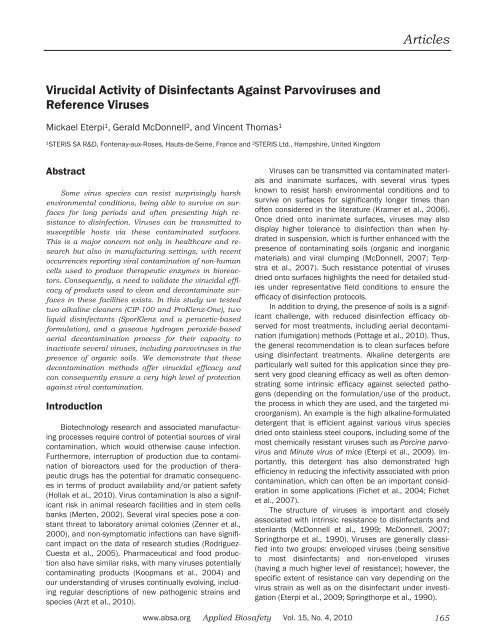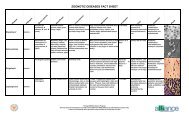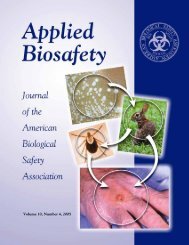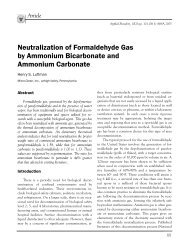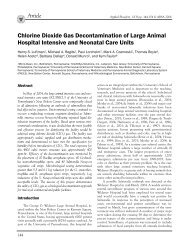Virucidal Activity of Disinfectants Against Parvoviruses - American ...
Virucidal Activity of Disinfectants Against Parvoviruses - American ...
Virucidal Activity of Disinfectants Against Parvoviruses - American ...
Create successful ePaper yourself
Turn your PDF publications into a flip-book with our unique Google optimized e-Paper software.
ArticlesTable 1List <strong>of</strong> cleaning products and biocides tested against viruses in this study.ProductCategory <strong>of</strong>ProductMain Compoundsin the FormulationCIP-100 Alkaline Detergent potassium hydroxideProKlenz-One Alkaline Detergent sodium hydroxidePAA-basedFormulationSporklenzRTUAtmosphericVHPSurface BiocideSurface BiocideAerial BiocidePAA 0.085%,H2O2 1%PAA 0.08%, H2O2 1%,acetic acid < 10%gaseous hydrogenperoxidepH12.4(1% solution)12.5(1% solution)Recommended Use ConditionsConcentrationsTemperatures1 to 6% 20°C to 55°C1 to 6% 20°C to 55°C1.5 to 2.0 na room temperature1.5 to 2.0 na room temperaturena250 (room) to 5,000 ppm(small volumes)na: not applicableBiocidalTreatmentCleaningProductsna: not applicableConcentrationTable 2TCID50 Log10 reductions observed after treatment <strong>of</strong> viruses dried onstainless steel coupons with or without the presence <strong>of</strong> organic soils.ContactTimeInterferingSubstanceTemp. VacciniaVirusAdenovirus PoliovirusPorcineParvovirusMinuteVirus <strong>of</strong>MiceCIP-100 0.9% 10 min BSA+blood 20°C >4.0 >4.0 >4.0 >4.0 >4.0ProKlenz-OneLiquid<strong>Disinfectants</strong>PAA-basedFormulationSporklenzRTUGaseousDisinfectantAtmosphericVHP0.9% 5 min none 45°C >4.0 >4.0 >4.0 >4.0 >4.01.9 ± 3.9 ±0.9% 10 min BSA+blood 20°C >4.0 >4.0 >4.00.4 0.50.9% 5 min none 45°C >4.0 >4.0 >4.0 >4.0 >4.0na 10 min BSA+blood 20°C >4.0 >4.0 >4.0 >4.0na 10 min BSA+blood 20°C >4.0 >4.0 >4.0 >4.0500 ppm 3 hr BSA+blood 20°C >4.0 >4.0 >4.0 >4.01000 ppm 2 hr BSA+blood 20°C >4.0 >4.01200 ppm 1 hr BSA+blood 20°C >4.0 >4.02000 ppm 30 min BSA+blood 20°C >4.0 >4.03.7 ±0.13.8 ±0.13.5 ±0.13.7 ±0.13.6 ±0.23.3 ±0.41.9 ±0.23.2 ±0.14.0 ±0.23.4 ±0.23.1 ±0.23.1 ±0.1www.absa.org Applied Biosafety Vol. 15, No. 4, 2010167
ArticlesResultsObserved titres <strong>of</strong> initial virus suspensions beforedeposition onto stainless steel coupons were: 8.7 log10/mL for Adenovirus, 9.0 log10/mL for Porcine parvovirus,7.7 log10/mL for Minute virus <strong>of</strong> mice, 9.0 log10/mL forPoliovirus, and 8.5 log10/mL for Vaccinia virus. It wasimportant to verify the effects <strong>of</strong> the test method aloneon each virus type, in the absence <strong>of</strong> any tested disinfectant.Viral loss due to drying alone was 1.0 log10 forall viruses, including for unexposed controls incubatedfor 3 hours at room temperature in gas fumigation studies.These results are significant because envelopedviruses are not generally considered to survive such dryingconditions but are clearly protected from inactivationby the presence <strong>of</strong> contaminating soils (even at low levels)and/or due to clumping.Neutralization was verified and was quantified at< 0.4-log10 reduction <strong>of</strong> virus titre after incubating eachneutralized product with each <strong>of</strong> the four virus speciesfor 30 minutes at room temperature (data not shown).Similarly, incubation <strong>of</strong> host cells for 30 minutes witheach neutralized product was verified at < 0.4-log10 reduction<strong>of</strong> virus titres (data not shown). Filtration throughMicrospin S-400 HR columns resulted in 0.2-log10 viralloss (data not shown).Alkaline detergents and formulated biocides presentedvery good activity against all viruses under theconditions tested (Table 2). CIP-100 achieved more than4-log reduction against all viruses in both tested conditions.ProKlenz-One was also efficient, particularly whenused at 45°C to simulate cleaning conditions, with onlythe Porcine parvovirus presenting some resistance whentested at room temperature in the presence <strong>of</strong> bloodand BSA soil load.The peracetic acid (PAA)-based biocide was also veryefficient against all viruses except against Minute virus<strong>of</strong> mice that presented a similar resistance level to whatwas observed for ProKlenz One against PPV; increasedtemperature was shown to overcome this effect (resultsnot shown). Similar results were shown with a furtherPAA-based biocide (SporKlenz RTU) with significant efficacyagainst MVM.Atmospheric decontamination with gaseous hydrogenperoxide under grossly soiled conditions was alsovery efficient, with > 4-log10 reductions observed for Vacciniavirus and Adenovirus in all tested conditions, > 3.5-log10 reductions observed for Poliovirus and PPV, and> 3-log10 reductions for MVM as the most resistant virusidentified in our study.DiscussionAs viral contamination is an increasing concern inmany research, pharmaceutical, and biotechnology applications,the objective <strong>of</strong> this work was to demonstratethat the use <strong>of</strong> cleaning chemistries (specifically alkalinebased)and/or chemical disinfection can ensure adequateviral titre reduction even in the presence <strong>of</strong> interferingsubstances. Our previous study demonstrated thatparvoviruses are the most challenging viruses for mostbiocides including ethanol, liquid hydrogen peroxide,aldehydes-based disinfectants, quaternary ammoniumcompounds, and sodium hypochlorite (Eterpi et al.,2009). It has also been shown that other non-envelopedviruses, such as coxsackieviruses, can also have significantlyhigher resistance levels than marker viruses usedfor disinfectant testing (e.g., Poliovirus) (Sattar et al.,1989). Parvorviruses were chosen as model organismsin our studies. Test viruses also included another small,non-enveloped species generally considered highly resistantto disinfection: type 1 Poliovirus strain Sabin, amoderately resistant, large non-enveloped virus: type 5Adenovirus, and a relatively sensitive enveloped virus:Vaccinia virus.The alkaline detergent CIP-100 contains a low concentration<strong>of</strong> potassium hydroxide as part <strong>of</strong> its formulation;it demonstrated very good activity with > 4-log10reduction for all viruses in the presence <strong>of</strong> blood andBSA. This detergent had previously demonstrated efficiencyagainst adenovirus type 5-based vectors in suspensionand various prion strains on surfaces (Fichet etal., 2004; Jannat et al., 2005). ProKlenz-One containssodium hydroxide; it was also very efficient against Adenovirus,Vaccinia virus, and Poliovirus in this study,whereas some resistance was observed for PPV and to alesser extent for MVM. ProKlenz-One used at 0.8% for10 minutes at room temperature was also fully efficientagainst the model prion strain 263K (Comoy et al., unpublishedresults according to methods described byFichet et al., 2004). Despite having the same pH, observeddifferences between activities <strong>of</strong> ProKlenz-Oneand CIP-100 against PPV highlight that differences informulation can be important when considering virucidalactivity. It should be noted that both formulations havehigh cleaning efficacy; in addition, specific and nonspecificmethods such as high-performance liquid chromatography(HPLC), Total Organic Compounds measurement,and others are available for detecting cleaningagent residues, which is required in the validation process(Resto et al., 2007).Viral inactivation results obtained with the alkalinecleaners have to be compared with results obtained withwidely used biocidal treatments under the same conditions.In a previous study we demonstrated that 70%ethanol is fully active only against Vaccinia virus andAdenovirus, with some resistance in Poliovirus inactivationand little to no activity against parvoviruses (Eterpiet al., 2009). In the same study, both parvoviruses werealso demonstrated to be very resistant to dry heat and tomoist heat (< 80°C), whereas the other species wereinactivated in these conditions; sodium hypochlorite0.25% presented only poor activity against PPV, whereasit was very efficient against other species, including168 www.absa.org Applied Biosafety Vol. 15, No. 4, 2010
ArticlesMVM (Eterpi et al., 2009). In the present study, both biocidalformulations tested (SporKlenz and the PAA-basedformulation) were effective against four tested virusesincluding PPV, whereas slight to moderate resistancewas observed for MVM. SporKlenz RTU is a mixture <strong>of</strong>PAA and hydrogen peroxide in formulation, with PAA beingthe predominant biocide; it has already demonstratedgood biocidal activity against bacterial bi<strong>of</strong>ilms aswell as relatively good elimination <strong>of</strong> bi<strong>of</strong>ilm materials(Knowles et al., 2005; Walker et al., 2003). PAA aloneand another 0.2% PAA-based formulation have also previouslybeen reported to present good virucidal activity(Eterpi et al., 2009). Our results confirm that despitebeing parvoviruses the Minute virus <strong>of</strong> mice and thePorcine parvovirus present different susceptibilities todifferent kinds <strong>of</strong> biocides: MVM seems to be moreresistant to acid-based treatments whereas PPV seemsto be more resistant to alkaline-based treatments.These differences may be due to subtle variations incapsid structure and can be readily overcome in combinationwith temperatures typically used for cleaning/disinfectant treatments (Simpson et al., 2002).Aerial decontamination with hydrogen peroxide gashas been demonstrated to be efficient against severalvirus species dried onto glass or stainless steel in thepresence <strong>of</strong> interfering substances (blood, serum, allantoicfluid) (Heckert et al., 1997). In this report, viruseswere exposed to 1,200 ppm hydrogen peroxide gas for30 minutes, resulting in complete inactivation <strong>of</strong> all virusesexcept for hog cholera virus dried in the presence<strong>of</strong> blood, whereas the same virus was completely inactivatedwhen dried in the presence <strong>of</strong> cell culture medium(Heckert et al., 1997). The presence <strong>of</strong> blood as an interferingsubstance was also demonstrated to be <strong>of</strong> criticalimportance in a recent study. Five- to 6-log10 reductionswere observed for MS2 bacteriophages exposed to hydrogenperoxide gas for 30 to 90 minutes; the addition<strong>of</strong> 10% blood resulted in a longer exposure (100 to 120minutes) required to achieve more than 6-log10 reduction,whereas the addition <strong>of</strong> 50% blood resulted in 3.5-to 4-log10 reduction after a 3-hour exposure to the sameconcentration (Pottage et al., 2010). This study alsodemonstrated that the VHP technology was more effectivethan a similar yet distinct condensing hydrogenperoxidesystem for inactivating bacteriophages in blood(Pottage et al., 2010). This observation is supported by arecent demonstration <strong>of</strong> the difference in mechanisms<strong>of</strong> action between gas and liquid peroxide (Finnegan etal., 2010; McDonnell, 2006). In our study, all virusstocks were filtered through Microspin S-400 HR columns(GE Healthcare, Fairfield, CT) to remove culturemedium components specific to cell lines used for virusproduction. The objective was to avoid any potential variabilityin virus inactivation that could be due to differentamounts <strong>of</strong> interfering substances present in the cellculture media used to produce infected cells. Blood andBSA were then added to virus suspensions before dryingonto coupons. We were interested in testing a range <strong>of</strong>exposure conditions that can be used for room (500ppm) or small-volume area (1,000 to 2,000 ppm) decontamination.All exposures resulted in relatively similarvirus reductions, with a slightly better efficacy with exposureat 500 ppm for 3 hours compared to shorter exposuresat higher concentrations (Table 2). This slight differencemight be due to the longer time required to penetratewithin dried blood, as previously shown in sporestudies (Meszaros et al., 2005). VHP technology hasalready been used by biotechnology companies for atmosphericdecontamination <strong>of</strong> animal research facilitiesto control and prevent transmission <strong>of</strong> parvoviruses(Batchelder et al., 2007; Koenig et al., 2007). It is alsoefficient to control bacterial spores contamination(Rogers et al., 2005) and has even been demonstratedefficient against prions in the presence <strong>of</strong> brain material(Fichet et al., 2004).In this study we were interested in testing the virucidalactivity <strong>of</strong> the alkaline products that are primarilyintended to clean surfaces, as well as liquid and gaseousbiocides that are used to inactivate micro-organismson pre-cleaned surfaces. We tested five different viralspecies in the presence <strong>of</strong> organic soils and confirmedthat parvoviruses are among the most resistant viruses.They can thus be used as a good model to ensure efficacy<strong>of</strong> validated products against the vast majority <strong>of</strong> virusspecies (Sattar, 2007). We demonstrated that cleaningsurfaces with certain alkaline detergents presents verygood cleaning efficacy and intrinsic virucidal activity.However, not all biocides present the same efficacyagainst viruses, with ethanol being poorly efficient andheat as well as sodium hypochlorite (bleach) presentinglimited efficacy depending on conditions tested (Figure1, Eterpi et al., 2009). In our experiments, tested biocidescontaining peracetic acid presented very goodoverall virucidal efficacy; however, observed differencesin susceptibility <strong>of</strong> different parvovirus species should betaken into account depending on the application. Atmosphericdecontamination with VHP presented good efficacyagainst all tested viruses including parvoviruses evenin the presence <strong>of</strong> blood. In general, this type <strong>of</strong> technologyis used following pre-cleaning, although it has beenshown to be very effective even under grossly soiled conditions(depending on the VHP concentration and exposuretime; [Heckert et al., 1997; Meszaros et al., 2005]).In conclusion, parvoviruses present high resistanceto inactivation, but a variety <strong>of</strong> cleaning and liquid/gaseous disinfectants can be safely used to reduce surfacecontamination risks.AcknowledgmentsThis work was partially funded by the DirectionGénérale des Entreprises (convention no. 072906389)under the French competitiveness cluster Medicen RégionIle-de-France. The authors are employed by STERISSA R&D, Fontenay-aux-Roses, Hauts-de-Seine, France orSTERIS Ltd., Hampshire, United Kingdom, as noted.www.absa.org Applied Biosafety Vol. 15, No. 4, 2010169
ArticlesFigure 1Hierarchical efficacy <strong>of</strong> various alkaline cleaners, biocides and gaseous decontamination treatments against the twoparvoviruses used in this and previous study (Eterpi et al., 2009). Results obtained with heat, ethanol and sodiumhypochlorite are reproduced from our previous study as a reference (Eterpi et al., 2009). All liquid chemicals (alkalinecleaners and biocides) were applied for 10 min at room temperature on viruses dried onto stainless steel couponsin the presence <strong>of</strong> blood and BSA. Viruses used for aerial decontamination tests were filtered through a MicrospinS-400 HR column (GE Healthcare) and dried onto stainless steel coupons in the presence <strong>of</strong> blood and BSA.Top panel: Results obtained with porcine parvovirus. Bottom panel: Results obtained with minute virus <strong>of</strong> mice.* : > 4-Log10 TCID50 reduction was observed.170 www.absa.org Applied Biosafety Vol. 15, No. 4, 2010
ArticlesReferencesAnonymous. (2005). BSEN 14476 (European Standard). Chemicaldisinfectants and antiseptics—<strong>Virucidal</strong> quantitative suspensiontest for chemical disinfectants and antiseptics usedin human medicine—Test method and requirements (phase2, step 1). European Standard EN 14476.Arzt, J., White, W. R., Thomsen, B. V., & Brown, C. C. (2010).Agricultural diseases on the move early in the third millennium.Veterinary Pathology, 47, 15-27.Batchelder, M., Mosher, H. E., Marks, G., & Tessman, D. M.(2007). Refinement <strong>of</strong> a vivarium quality assurance programby incorporation <strong>of</strong> vaporized hydrogen peroxide. Poster presentedat <strong>American</strong> Association for Laboratory Animal Science(AALAS) National Meeting, Charlotte, NC.Eterpi, M., McDonnell, G., & Thomas, V. (2009). Disinfectionefficacy against parvoviruses in comparison to referenceviruses. Journal <strong>of</strong> Hospital Infection, 73, 64-70.Fichet, G., Comoy, E., Dehen, C., Challier, L., Antloga, K., Deslys,J. P., et al. (2007). Investigations <strong>of</strong> a prion infectivity assay toevaluate methods <strong>of</strong> decontamination. Journal <strong>of</strong> MicrobiologicalMethods, 70, 511-518.Fichet, G., Comoy, E., Duval, C., Antloga, K., Dehen, C., Charbonnier,A., et al. (2004). Novel methods for disinfection <strong>of</strong>prion-contaminated medical devices. Lancet, 364, 521-526.Finnegan, M., Linley, E., Denyer, S. P., McDonnell, G., Simons,C., & Maillard, J. Y. (2010). Mode <strong>of</strong> action <strong>of</strong> hydrogen peroxideand other oxidizing agents: Differences between liquidand gas forms. Journal <strong>of</strong> Antimicrobial Chemotherapy, InPress, DOI: 10.1093/jac/dkq308.Heckert, R. A., Best, M., Jordan, L. T., Dulac, G. C., Eddington,D. L., & Sterritt, W. G. (1997). Efficacy <strong>of</strong> vaporized hydrogenperoxide against exotic animal viruses. Applied and EnvironmentalMicrobiology, 63, 3916-3918.Hollak, C. E., vom Dahl, S., Aerts, J. M., Belmatoug, N., Bembi,B., Cohen, Y., et al. (2010). Force majeure: Therapeuticmeasures in response to restricted supply <strong>of</strong> imiglucerase(Cerezyme) for patients with Gaucher disease. Blood Cells,Molecules, and Diseases, 44, 41-47.Hultman, C., Hill, A., & McDonnell, G. (2007). The physicalchemistry <strong>of</strong> decontamination with gaseous hydrogen peroxide.Pharmaceutical Engineering, 27, 1-6.Jannat, R., Hsu, D., & Maheshwari, G. (2005). Inactivation <strong>of</strong>adenovirus type 5 by caustics. Biotechnology Progress, 21,446-450.Karber, G. (1931). Beitrag zur kollektiven Behandlung pharmakologischerReiheversuche. Arch. Exp. Pathol. Pharmakol.,162, 480-483.Knowles, J. R., Roller, S., Murray, D. B., & Naidu, A. S. (2005).Antimicrobial action <strong>of</strong> carvacrol at different stages <strong>of</strong> dualspeciesbi<strong>of</strong>ilm development by Staphylococcus aureus andSalmonella enterica serovar Typhimurium. Applied and EnvironmentalMicrobiology, 71, 797-803.Koenig, M., & Smith G. D. (2007). Strategies for elimination <strong>of</strong>mouse parvovirus. Poster presented at <strong>American</strong> Associationfor Laboratory Animal Science (AALAS) National Meeting,Charlotte, NC.Koopmans, M., & Duizer, E. (2004). Foodborne viruses: Anemerging problem. International Journal <strong>of</strong> Food Microbiology,90, 23-41.Kramer, A., Schwebke, I., & Kampf, G. (2006). How long donosocomial pathogens persist on inanimate surfaces? Asystematic review. BMC Infectious Diseases, 6, 130.McDonnell, G. (2006). Hydrogen peroxide fogging/fumigation.Journal <strong>of</strong> Hospital Infection, 62, 385-386.McDonnell, G. (2007). Antisepsis, disinfection and sterilization:Types, action and resistance. Washington, DC: ASM Press.McDonnell, G., & Russell, A. D. (1999). Antiseptics and disinfectants:<strong>Activity</strong>, action, and resistance. Clinical MicrobiologyReviews, 12, 147-179.Merten, O. W. (2002). Virus contaminations <strong>of</strong> cell cultures—A biotechnological view. Cytotechnology, 39, 91-116.Meszaros, J. E., Antloga, K., Justi, C., Plesnicher, C., & McDonnell,G. (2005). Area fumigation with hydrogen peroxide vapor.Applied Biosafety: Journal <strong>of</strong> the <strong>American</strong> BiologicalSafety Association, 10(2), 91-100.Pottage, T., Richardson, C., Parks, S., Walker, J. T., & Bennett,A. M. (2010). Evaluation <strong>of</strong> hydrogen peroxide gaseous disinfectionsystems to decontaminate viruses. Journal <strong>of</strong> HospitalInfection, 74, 55-61.Resto, W., Hernandez, D., Rey, R., Colon, H., & Zayas, J. (2007).Cleaning validation 2: Development and validation <strong>of</strong> an ionchromatographic method for the detection <strong>of</strong> traces <strong>of</strong> CIP-100 detergent. Journal <strong>of</strong> Pharmaceutical and BiomedicalAnalysis, 44, 265-269.Rodriguez-Cuesta, J., Vidal-Vanaclocha, F., Mendoza, L., Valcarcel,M., Gallot, N., & Martinez de Tejada, G. (2005). Effect <strong>of</strong>asymptomatic natural infections due to common mousepathogens on the metastatic progression <strong>of</strong> B16 murinemelanoma in C57BL/6 mice. Clinical & Experimental Metastasis,22, 549-558.Rogers, J. V., Sabourin, C. L., Choi, Y. W., Richter, W. R., Rudnicki,D. C., Riggs, K. B., et al. (2005). Decontamination assessment<strong>of</strong> Bacillus anthracis, Bacillus subtilis, and Geobacillusstearothermophilus spores on indoor surfaces usinga hydrogen peroxide gas generator. Journal <strong>of</strong> Applied Microbiology,99, 739-748.Sattar, S. A. (2007). Hierarchy <strong>of</strong> susceptibility <strong>of</strong> viruses toenvironmental surface disinfectants: A predictor <strong>of</strong> activityagainst new and emerging viral pathogens. Journal <strong>of</strong> AOACInternational, 90, 1655-1658.Sattar, S. A., Springthorpe, V. S., Karim, Y., & Loro, P. (1989).Chemical disinfection <strong>of</strong> non-porous inanimate surfacesexperimentally contaminated with four human pathogenicviruses. Epidemiology and Infection, 102, 493-505.Simpson, A. A., Hebert, B., Sullivan, G. M., Parrish, C. R., Zadori,Z., Tijssen, P., et al. (2002). The structure <strong>of</strong> porcine parvovirus:Comparison with related viruses. Journal <strong>of</strong> MolecularBiology, 315, 1189-1198.Springthorpe, V. S., & Sattar, S. A. (1990). Chemical disinfection<strong>of</strong> virus-contaminated surfaces. Critical Reviews in EnvironmentalControl, 20, 169-229.Terpstra, F. G., van den Blink, A. E., Bos, L. M., Boots, A.G., Brinkhuis, F. H., Gijsen, E., et al. (2007). Resistance <strong>of</strong>surface-dried virus to common disinfection procedures. Journal<strong>of</strong> Hospital Infection, 66, 332-338.Walker, J. T., Bradshaw, D. J., Fulford, M. R., & Marsh, P. D.(2003). Microbiological evaluation <strong>of</strong> a range <strong>of</strong> disinfectantproducts to control mixed-species bi<strong>of</strong>ilm contamination in alaboratory model <strong>of</strong> a dental unit water system. Applied andEnvironmental Microbiology, 69, 3327-3332.Zenner, L., & Regnault, J. P. (2000). Ten-year long monitoring<strong>of</strong> laboratory mouse and rat colonies in French facilities: Aretrospective study. Laboratory Animals, 34, 76-83.www.absa.org Applied Biosafety Vol. 15, No. 4, 2010171


